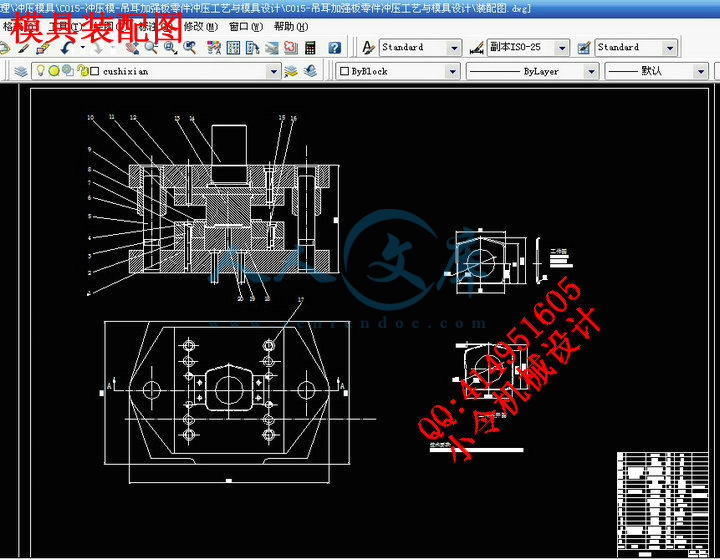摘要:近年来,我国家电工业的高速发展对模具工业,尤其是冷冲模具提出了越来越高的要求,2004年,冷冲模具在整个模具行业中所占比例已大大上升,据有关专家预测,在未来几年中,中国冷冲模具工业还将持续保持年均增长速度达到15%左右的较高速度的发展。
冲压成型是金属成型的一种重要方法,它主要适用于材质较软的金属成型,可以一次成型形状复杂的精密制件。本课题就是将石化、化工、电力等行业的法兰密封结构中的垫片作为设计模型,将冷冲模具的相关知识作为依据,阐述冷冲模具的设计过程。
本设计对带法兰U型件进行的模具设计,利用Auto CAD软件对制件进行设计绘图。明确了设计思路,确定了冲压成型工艺过程并对各个具体部分进行了详细的计算和校核。如此设计出的结构可确保模具工作运用可靠,保证了与其他部件的配合。并绘制了模具的装配图和零件图。
本课题通过对工件的冲压模具设计,巩固和深化了所学知识,取得了比较满意的效果,达到了预期的设计意图。
关键词:冲压模具;冲压成型;模具设计
Abstract:In recent years, the rapid development of China's household electrical appliance industry of mold industry, especially Die with the increasing demands put forward in 2004, Die in the proportion of the entire mold industry has been greatly increased, experts predict, In the next few years, China will continue to maintain industrial Die average annual growth rate reached 15% of the high rate of development.
Stamping is an important method of metal forming, it is mainly applied to relatively soft metal forming, can be a molding of precision parts of complex shape. This topic is to petrochemical, chemical, electric power industries in the flange gasket sealing structure as a design model, Die related knowledge as a basis to explain the design process of Die.
The design of the U-piece with a flange to the mold design, the use of Auto CAD software to design parts drawing. Clear design ideas, determine the process of stamping and forming part of the various specific details of the calculation and verification. The structure of such a design die is used to ensure reliability, ensure coordination with other components. And the mapping of the mold assembly and part drawings.
The subject of the workpiece by stamping die design, consolidate and deepen the knowledge, and achieved satisfactory results, to achieve the desired design intent.
Keywords: stamping die; stamping molding; die design
目录
1 绪 论3
1.1 模具行业的发展现状及市场前景3
1.2 冲压工艺介绍3
1.3 冲压工艺的种类4
1.4 冲压行业阻力和障碍与突破4
2 工件的工艺分析7
2.1 工件材料7
2.2 工件结构形状7
2.3 工件尺寸精度7
2.4 工件展开长度计算8
3 工艺方案的确定11
4 模具结构形式的确定13
5 模具总体设计14
5.1 模具类型的选择14
5.2 操作方式14
5.3 卸料、出件方式14
5.4 确定导向方式14
6 模具设计计算15
6.1 弯曲力的计算15
6.2 顶件力的计算 15
6.3 压力中心的确定16
6.4 模具工作部分零件尺寸计算16
7 主要零部件设计20
7.1 工作零部件的结构设计20
8 校核模具闭合高度及压力机有关参数25
8.1 校核模具闭合高度25
8.2 冲压设备的选定25
9 设计并绘制模具总装图及选取标准件27
10 模具的安装调试28
10.1 模具的安装调试28
结论 29
参考文献 30
致谢 31
1 绪论
1.1 模具行业的发展现状及市场前景
现代模具工业有“不衰亡工业”之称。世界模具市场总体上供不应求,市场需求量维持在600亿至650亿美元,同时,我国的模具产业也迎来了新一轮的发展机遇。近几年,我国模具产业总产值保持13%的年增长率(据不完全统计,2004年国内模具进口总值达到600多亿,同时,有近200个亿的出口),到2005年模具产值预计为600亿元,模具及模具标准件出口将从现在的每年9000多万美元增长到2005年的2亿美元左右。单就汽车产业而言,一个型号的汽车所需模具达几千副,价值上亿元,而当汽车更换车型时约有80%的模具需要更换。2003年我国汽车产销量均突破400万辆,预计2004年产销量各突破500万辆,轿车产量将达到260万辆。另外,电子和通讯产品对模具的需求也非常大,在发达国家往往占到模具市场总量的20%之多。目前,中国17000多个模具生产厂点,从业人数约50多万。1999年中国模具工业总产值已达245亿元人民币。工业总产值中企业自产自用的约占三分之二,作为商品销售的约占三分之一。在模具工业的总产值中,冲压模具约占50%,塑料模具约占33%,压铸模具约占6%,其它各类模具约占11%。
1.2 冲压工艺介绍
冲压是靠压力机和模具对板材、带材、管材和型材等施加外力,使之产生塑性变形或分离,从而获得所需形状和尺寸的工件(冲压件)的成形加工方法。冲压和锻造同属塑性加工(或称压力加工),合称锻压。冲压的坯料主要是热轧和冷轧的钢板和钢带。
全世界的钢材中,有60~70%是板材,其中大部分是经过冲压制成成品。汽车的车身、底盘、油箱、散热器片,锅炉的汽包、容器的壳体、电机、电器的铁芯硅钢片等都是冲压加工的。仪器仪表、家用电器、自行车、办公机械、生活器皿等产品中,也有大量冲压件。
冲压件与铸件、锻件相比,具有薄、匀、轻、强的特点。冲压可制出其他方法难于制造的带有加强筋、肋、起伏或翻边的工件,以提高其刚性。由于采用精密模具,工件精度可达微米级,且重复精度高、规格一致,可以冲压出孔、凸台等。
冷冲压件一般不再经切削加工,或仅需要少量的切削加工。热冲压件精度和表面状态低于冷冲压件,但仍优于铸件、锻件,切削加工量少。
冲压是高效的生产方法,采用复合模,尤其是多工位级进模,可在一台压力机上完成多道冲压工序,实现由带料开卷、矫平、冲裁到成形、精整的全自动生产。生产效率高,劳动条件好,生产成本低,一般每分钟可生产数百件。




 川公网安备: 51019002004831号
川公网安备: 51019002004831号